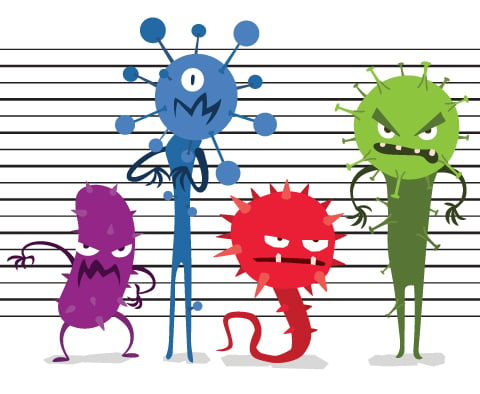Periprosthetic Joint Infection (PJI)
PJI is a serious complication of joint replacements of the hip, knee, shoulder, elbow, wrist or ankle. Bacteria may infect the artificial joint (prosthesis) during or after surgery, causing infection.
Infections that affect the site of the incision (the cut made through the skin to do the procedure) may occur anywhere from a few days to up to three months following surgery. Infections of the tissue surrounding the prosthesis may occur up to two years after surgery, and can cause significant pain. Infection can also damage the new joint, requiring a second replacement.
According to the American Journal of Orthopedics, up to 2% of the hundreds of thousands of joint replacements performed every year in the U.S. become infected. This translates into thousands of infections annually.
In up to 50% of PJI cases, standard cultures fail to identify the organism causing the infection, making it difficult to determine which drug to use to treat it. This is why a MicroGenDX test for PJI is so important.
PJI Symptoms
Common PJI symptoms include:
- Pain, redness or warmth at the incision site
- Liquid or pus draining from the incision site
- Swelling around the joint
- Limited range of motion in the joint
- Fever, chills or night sweats
MicroGenDX Tests Can Diagnose PJI
To treat a PJI, your doctor needs to know if the joint is infected and which organism is causing the infection. Growing microbes from your sample in a lab, also known as a culture, is often used to try to diagnose PJI infections. However, about half the time, standard cultures either come back negative even when you actually have an infection, or if they diagnose an infection, they can’t pinpoint the organism that’s actually causing it. That means your infection won’t be treated properly (some providers prescribe antibiotics but have no way of knowing if the antibiotic is targeting the right bacteria) or it won’t be treated at all.
An international consensus meeting on orthopedic infections held in 2018 states that “molecular diagnosis” should be used to isolate the organisms causing PJI. Molecular diagnosis is what the MicroGenDX OrthoKEY PJI test provides. Rather than relying on standard culture, OrthoKEY detects the DNA of all microbes in your sample along with how much of each is present. This information is used to identify the specific cause of the infection and the drugs that can best treat it. Your doctor can use a single test in the operating room (OR) or the clinic.
You can see more information about MicroGenDX PJI tests here:
OrthoKEY PJI Clinic – https://microgendx.com/product/orthokey-clinic-test-service-dm-intl/
OrthoKEY PJI OR – https://microgendx.com/product/orthokey-surgery-test-service-dm-intl/
Providing Samples for MicroGenDX Tests
Everything your physician needs to know about how PJI samples are taken is included with the test. It’s also available online on the OrthoKEY PJI Clinic and OrthoKEY PJI OR product pages. The instructions included with the tests contain illustrations to help your doctor collect a sample without contaminating it. It’s always important to obtain a proper sample by following the instructions for collecting the sample, as well as when packaging and shipping it. For example, to be sure not to contaminate the sample by touching it.
For the OrthoKEY PJI OR sample, your doctor will make an incision and transfer a fluid sample into the collection vial. Then, using specially developed swabs, the doctor will take samples from the implant and surrounding tissue and put the swabs into the two provided specimen tubes.
For the OrthoKEY PJI CLINIC sample, your doctor will take a fluid sample using a needle and syringe (a process called “aspiration”). Your doctor may take tissue samples, as well, if they think this will be helpful. You will not be given lidocaine or a local anesthetic before the clinic sample is collected because the anesthetic can interfere with the sample analysis.
Medical Specialties Treating PJI
Prompt identification is important to prevent further complications or spread of the infection. Treatment can involve a team of experts such as an orthopedic surgeon, a wound care nurse, an infectious disease consultant, and a physical therapist.
How PJI is Treated
When an infection is present, the MicroGenDX test will indicate options for antibiotics your specialist can prescribe to treat the infection in the “antimicrobials for consideration” section of the test results. In some cases, the wound (usually around the incision site) is reopened, and infected tissue is removed (a process called debridement) while leaving the new joint in place. Sometimes, all or part of the artificial joint may need to be replaced.
References
- https://journals.lww.com/jbjsjournal/Abstract/2018/01170/Diagnosis_of_Periprosthetic_Joint_Infection__The.8.aspx
- https://microgendx.com/?s=Periprosthetic+joint+infection
- https://www.nm.org/conditions-and-care-areas/infectious-disease/prosthetic-joint-infections
- https://www.merckmanuals.com/home/bone,-joint,-and-muscle-disorders/bone-and-joint-infections/artificial-joint-infectious-arthritis
- https://online.boneandjoint.org.uk/doi/full/10.1302/0301-620X.99B4.BJJ-2016-1212.R1
- https://www.sciencedirect.com/topics/medicine-and-dentistry/periprosthetic-joint-infection
- https://pubmed.ncbi.nlm.nih.gov/32192834/
- https://www.mayoclinic.org/medical-professionals/orthopedic-surgery/news/specialized-care-for-infected-joints/mac-20431109

